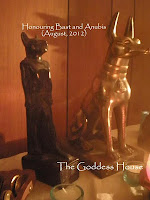The August service at The Goddess House carried an Egyptian theme Bast (the cat headed Goddess associated with women and the moon) and Anubis (the jackal headed God associated with guiding the souls into the Underworld) were honoured.
Probably the most famous Egyptian Goddess after Isis, Bast (or Bastet) was believed to have originally been a Sun Goddess, but during the Greek rule of Egypt, she became associated with Artemis and the Moon.
She was worshipped since at least the Second Dynasty (2,890 to 2,686 BCE), where she appeared as either a fierce lioness or a woman with the head of a lion. Originally she was viewed as the protector Goddess of Lower Egypt. As such, was the defender of the pharaoh, and later of Ra (where she gained the title “Lady of the Flame” and “Eye of Ra”). After the unification of Egypt, this aspect was believed to have been taken over by Sekhmet, a similar lion headed Goddess who originated by Upper Egypt.
Her cult centre at Bubastis became the Egyptian capital during the Later Period (664 BC until 332 BCE), and the Greek writer Herodotus described her temple there as a place of great splendour and beauty with its pink granite temples and tree lined entrances, and that it rivalled only those of Ra and Horus.
According to myth, in her cat form, Bast guarded Ra (sometimes described as her father) from his greatest enemy, the serpent Apep (also known as Apophis). She was accredited with killing Apep to ensure the warmth of the sun would continue to bless the delta of the Nile with fertile soil and abundant crops. This connected Bast with fertility.
Anubis is the jackal headed God commonly considered to have been born from the liaison between Osiris and his young sister Nephthys, however it is considered that he pre-dates this story as the oldest mastabas of the Old Kingdom contain prayers to him carved into their walls. He is mentioned in the Pyramid Texts as a guardian and protector of the dead. A standard offering formula for the dead in the Old Kingdom began thusly: “An offering which the king gives and Anubis, who is upon his mountain and in the place of embalming, the lord of the necropolis …”.
Originally Anubis was the lord of the dead but assumed the role of the guide who holds steady the scales on which the hearts of the dead are measured against the feather of Ma'at. He was also Imy-ut (“He who is in the Place of Embalming"), the embalmer who washes the entrails of the dead and guards over their physical bodies. Priests would wear a mask of Anubis during the “Opening of the Mouth” rite which was to reawakened a dead person's senses.
Anubis was worshipped throughout Egypt, but his cult centre was in Cynopolis (Upper Egypt).




ReplyDeleteAwesome post, thanks for sharing
Best Endodontist in Bangalore, Contact us best endodontist in bangalore